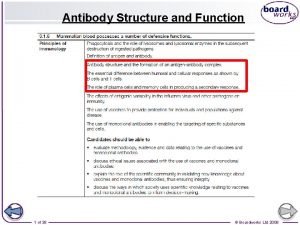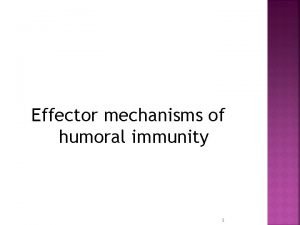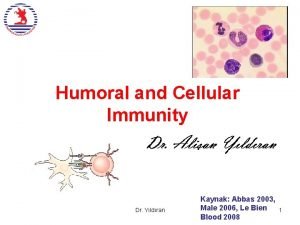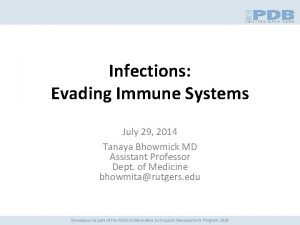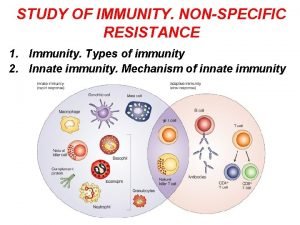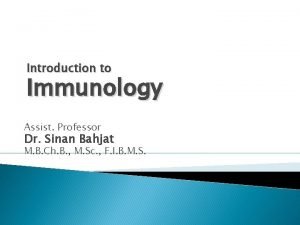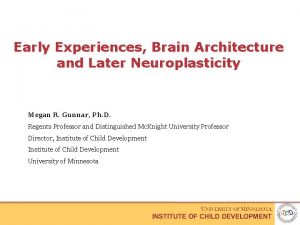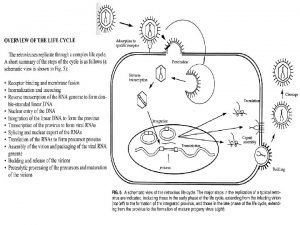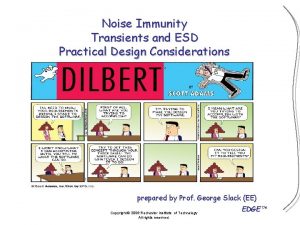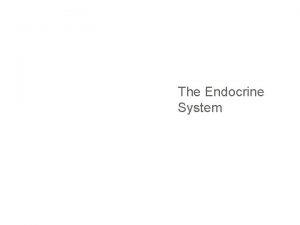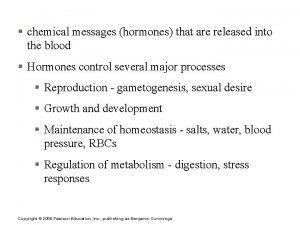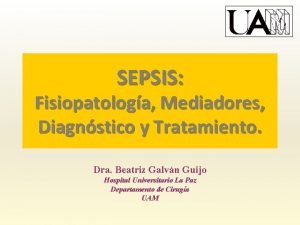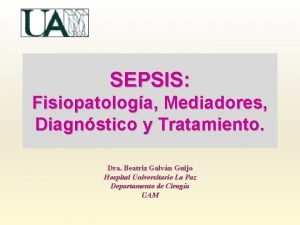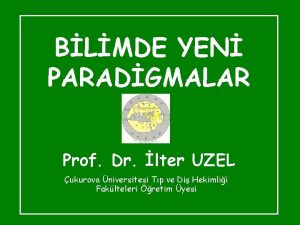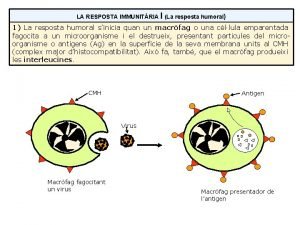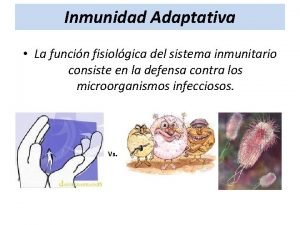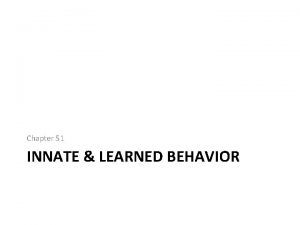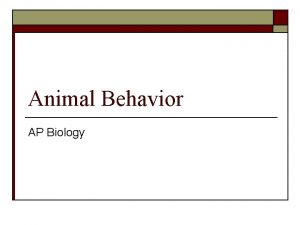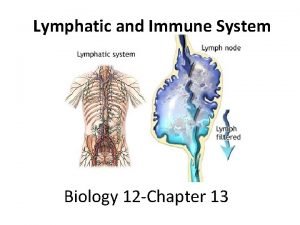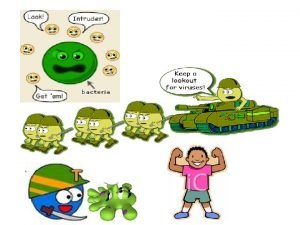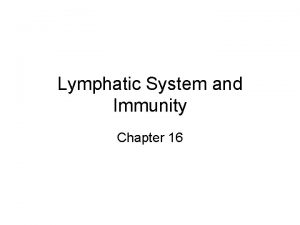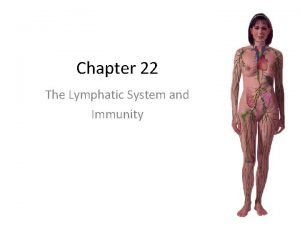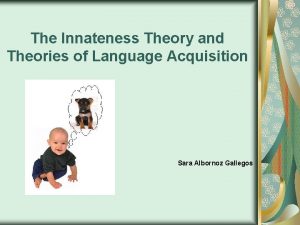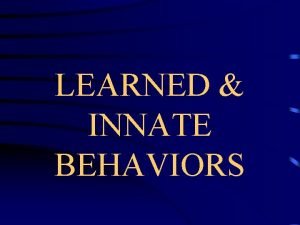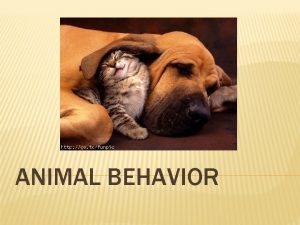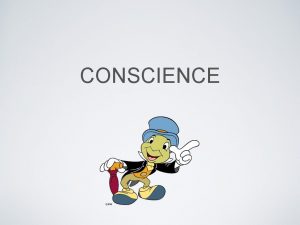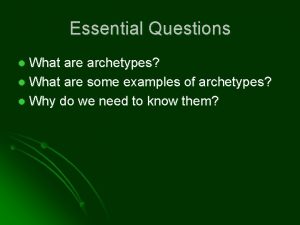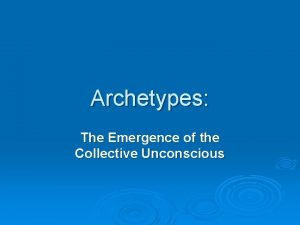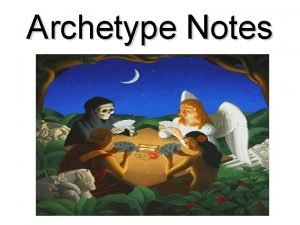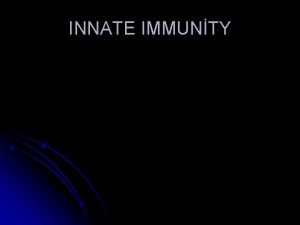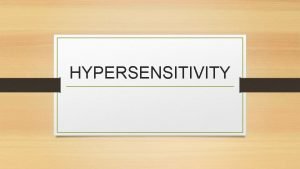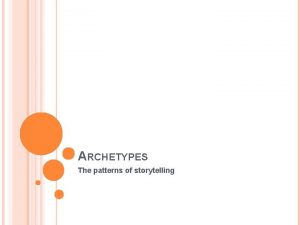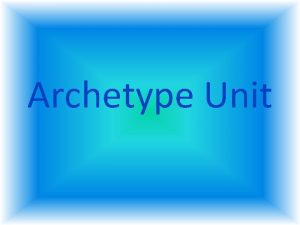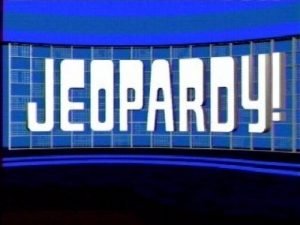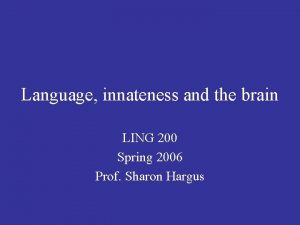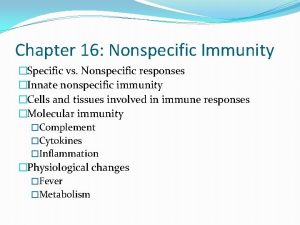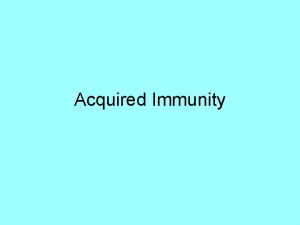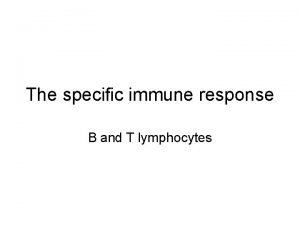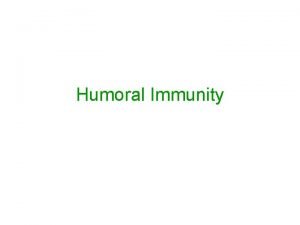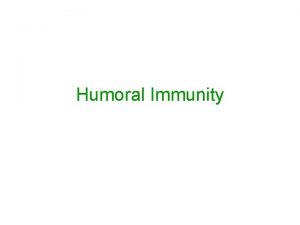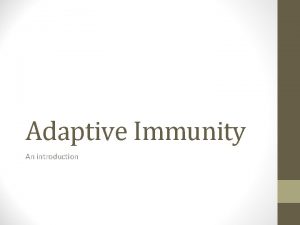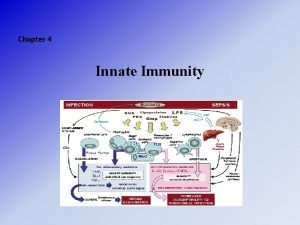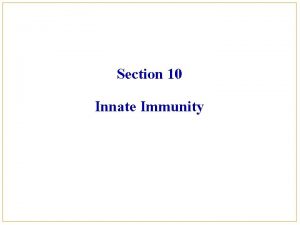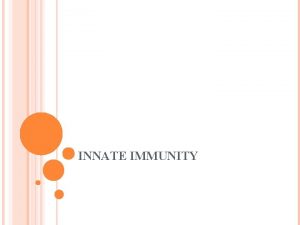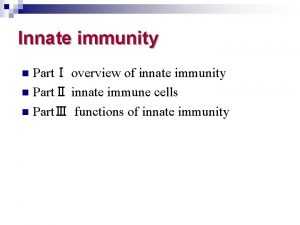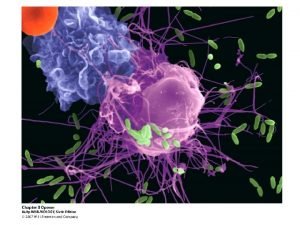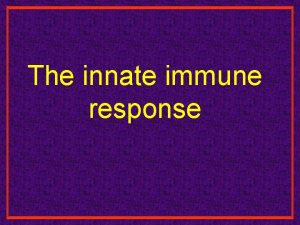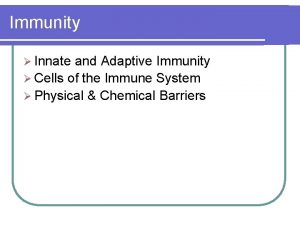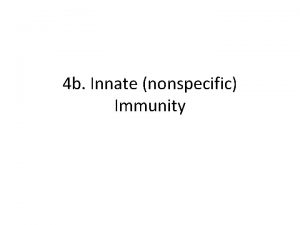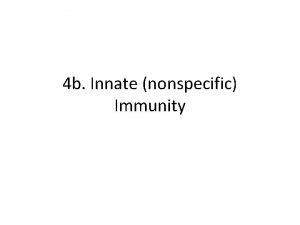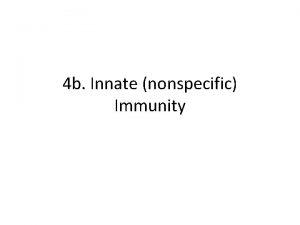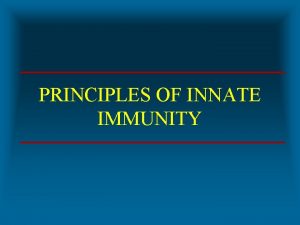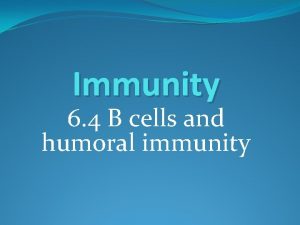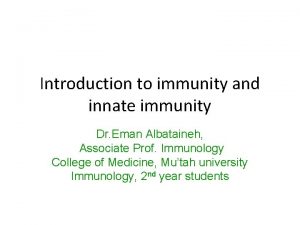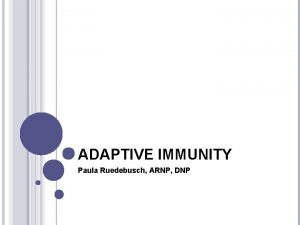Adaptive Immunity I Innate and Adaptive Immunity Humoral





































































- Slides: 69

Adaptive Immunity I

Innate and Adaptive Immunity Humoral Cellular

Characteristics of the IR Innate Adaptive • Broad specificity • Recognizes molecular patterns • Rapid response • No memory • Narrow specificity • Recognizes specific antigens • Delayed response (why? ) • Memory

Functions of the (innate) immune system • • • Barriers: Physical, chemical, microbial Recognition: PAMPs, other receptors Remove and destroy: Phagocytes Distinguish self and non-self: Phagocytes, NK cells Memory?

Functions of the adaptive IR • Barriers: • Recognition: • Remove and destroy: Distinguish self and non-self: • Memory?

The adaptive immune response A brief overview

Zing!! Y Y Y Y Y T M Y B Zing!! Th Zing!! Tc Zing!! P Y Y Y M Y Y Zing!! Y Y Y Y Th 1 Th 2 Treg Th 17 Y Y



Topics for today • • • Antigen receptors Antibody structure and function Antigen presentation and MHC restriction Antibody receptor rearrangement MHC diversity

Antigens and antigen receptors • Antigen: A macromolecule (usually protein) that is specifically recognized by an antibody. • “Generates an antibody” • Antibody: A molecule that is produced in response to and is specific for a particular antigen. • Antigen = Anything that induces an adaptive immune response.

Antigen receptors come in two flavors Antibodies T cell receptors • • Made by B cells Cell-associated and soluble Bivalent Recognize antigen directly Expressed by T cells Cell associated Monovalent Recognize antigen in conjunction with MHC Both: • Recognize specific antigens • Each B or T cell expresses a single antigen specificity One cell, one antibody or T cell receptor, one antigen

Antibody structure: “lock and key” Bivalent: Two identical antigen binding sites

Epitopes


Figure 3 -1 part 3 of 3 Antigenbinding

Figure 3 -1 part 1 of 3

Anatomy of an antibody • Fab : – Antigen binding – Variable region – Confers antigen specificity – Different for every antibody • Fc: – Constant regions – Confers Fc receptor binding on immune cells – Crystalized

Classification of antibodies: • Idiotype: antigen binding specificity: – – Variable region B cells only produce a single idiotype A single idiotype may recognize closely related antigens Defined by Fab • Isotype: heavy chain structure (antibody “class”) – Defined by their Fc domain – Named for popular letters of the alphabet: Ig(immunoglobulin)G, Ig. A, Ig. M – Different isotypes have different functions

Idiotype vs Isotype • Antigen specificity • Conferred by variable region • Independent of isotype • Antibody class • Ig. G, Ig. M, Ig. A, Ig. E, etc • Conferred by constant region • Antibodies of different isotypes may have the same idotype (antigen specificity)

Isotype structure Monomeric Ig. M Ig. G Pentameric Ig. M Ig. E Ig. A http: //www. microbiologybook. org/mayer/Ig. Struct 2000. htm

Isotype structure • Valency: – Monomers = bivalent – Multimers = multivalent Ig. G Pentameric Ig. M • Fc fragment domains: – Two or three domains – Determine receptor binding: • Multimers • Immune cell activation – Fc receptors present on various types of immune cells

Isotype function • Fc fragment determines receptor binding • Ig. M: – Surface receptor: cell associated antibody – Primary response: initial antigen recognition • Ig. G: – Most abundant isotype – Antigens in serum – Bacteria, viruses, toxins • Ig. E: Allergens, parasitic antigens • Ig. A: Mucosal immunity

Antibody function: Antigen removal Y Y Y Y Y – B cell activation – Antibody-dependent cellular cytotoxicity P Y Agglutination Complement fixation Opsonization Neutralization Activation of immune cells: Y • • •

Agglutination Ig. G Ig. M • Pathogen/toxin inactivation • Enhanced phagocytosis

Complement fixation (activation)

Opsonization and phagocytosis


Neutralization Toxin Neutralization C ^ Virus neutralization

http: //www. colorado. edu/intphys/Class/IPHY 3430 -200/014 immune. htm

The T cell receptor • Surface receptor • Structure: – a and b chains – Variable and constant regions – Antigen-specific • Recognizes antigen presented by the major histocompatibility complex (MHC)

Antibody: • Soluble or membrane bound • Heavy and light chains • Variable and constant regions • Bivalent T cell receptor: • Membrane bound • a and b chains • Variable and constant regions • Monovalent

Antigen recognition • B cell receptors (antibody) recognize antigen directly • T cell receptors recognize antigen only in conjunction with MHC molecules on the surface of antigen presenting cells

Antibody-antigen interaction T cell receptor antigen interaction

MHC restriction Th • T cells recognize antigen bound to MHC • MHC molecules come in 2 flavors: – MHCI: Present on all nucleated cells – MHCII: Present on antigen presenting cells • T cells are MHC restricted – Helper T cells recognize antigen bound to MHCII – Cytotoxic T cells recognize antigen bound to MHCI Tc

Helper T cells are MHC II restricted Cytokines Cytotoxic T cells are MHC I restricted

Antigen presentation

MHC structure: MHC I • Two chains: a, b 2 microglobulin • Peptide-binding cleft • Three globular domains • a 1 and a 2 peptide binding • a 3 constant

MHC structure: MHCII • a and b chains • Peptide-binding cleft • Peptide binding and constant domains

How the peptide gets into the binding cleft: Antigen processing • MHCI – Intracellular antigens – Cytoplasmic processing • MHCII – Extracellular antigens – Endosome processing

Antigen Processing Thought question: Why is processing different for MHCI vs MHCII?

Antigen receptors: Specificity and diversity • • 1015+ different antigen specificities Virtually every antigen ever invented But not self antigens Where does the diversity come from?

The origins of antibody diversity • Germ line theory: – One gene in the germ line for every variable region – 1015 antibody genes? – Nope • Somatic mutation theory: – Only a few variable region genes – Contact with antigen induces mutations resulting in (with luck) a matching sequence • Both are true • Neither is true

Combined theory of antibody diversity • Antibody genes contain many different coding sequences • Extensive recombination occurs during B cell maturation • Diversity is generated by: – – Random combinations Junctional diversity Sloppy recombination Pairing of heavy and light chains • Each B or Tcell clone expresses a unique antibody sequence • Relevant clones are selected

Antibody genes: Germline • Heavy and light chain loci • Each has multiple coding sequences: – Variable region: multiple sequences – Constant region: multiple sequences • Random recombination

Variable region genes • Each cell has two light chain loci (k and l) and one heavy chain locus. • Each light chain variable locus has: – V (variable) regions – J (joining) regions • Each heavy chain variable locus has: – V regions – J regions – D (diversity) regions • Multiple alternative sequences for each region • Random rearrangement during maturation results in one VL, one JL, one VH, one JH, and one DH

Antibody genes: Germ-line structure L H H L • Two light chain loci • V, D, and J regions • Up to 40 regions in each category • Randomly recombine


T cell receptor rearrangement

Factors that contribute to antigen receptor diversity • V, J, D gene variability: Large number of genes • V, J, D gene joining: – Selection – Order – Orientation • Junctional diversity: – Sloppy recombination – N region insertion • Heavy and light gene selection


Recombination activating genes (RAG) • • RAG 1 and RAG 2 Enzyme complex Catalyze recombination and joining Essential for development of mature B and T cells


Somatic hypermutation • Enhanced diversity and specificity after antigen contact • Occurs in peripheral tissues in mature B cells only • Rapidly accumulating point mutations in V regions • Selection for best fit • Increases strength of binding

Somatic hypermutation

MHC diversity • B and T cells are clonal: – Each cell expresses a single receptor type – Each cell is specific for one antigen type • Antigen-presenting cells have multiple specificities – Each cell may express several different MHC types – Each MHC molecule may associate with several different antigens

Y Y B Y Y T Y APC Y Y B Y Y Y B T

Genetics of the MHC • • Germ-line expression: no rearrangement Multiple genes present in the germ line Co-dominant expression Multiple alleles present in the population

MHC locus • Three regions: – MHCI and MHCII: Encode antigenpresentation molecules – MHCIII: Complement genes, some cytokine genes, others • Each MHC region has several genes – MHCI: A, B, C – MHCII: DP, DQ, DR – Each MHCII gene encodes a and b chains


MHC diversity • MHC presents all possible epitopes • No somatic rearrangement • Each cell expresses multiple MHC molecules • Genetic polymorphism • High mutation rate • Degenerate peptide binding

Genetic polymorphism • • • Multiple MHC genes Many alleles for each gene Multiple combinations Inherited independently Expression is co-dominant Population-wide diversity > individual diversity

Polymorphism of MHCII genes Locus HLA-DPA HLA-DPB HLA-DQA HLA-DQB HLA-DRA HLA-DRB 1 HLA-DRB 3 HLA-DRB 4 Number of alleles 12 HLA-DRB 5 http: //pathmicro. med. sc. edu/bowers/mhc. htm 88 17 42 2 269 30 7 12

MHC Peptide binding • MHC-antigen binding differs from B and T cell antigen receptor binding: • “Degenerate” binding: Binding is not antigen-specific. A single MHC molecule can associate with many different peptides • Each antigen-presenting cell expresses several different MHC specificities • Different MHC on one cell can bind different peptides • Each cell can present many different peptides

Diversity: antigen receptor vs MHC • Antigen receptor : – Each cell encodes a single polypeptide sequence – One receptor specificity per cell – V region selection – Junctional diversity – Somatic hypermutation • MHC : – Each cell encodes multiple genes and multiple alleles – multiple MHC proteins per cell – Degenerate peptide binding – No gene rearrangement – Polymorphic: up to 600 alleles for each locus

The role of diversity Antigen receptor diversity MHC diversity • Recognition of all possible • Limited diversity of individuals antigens by the individual • Extensive diversity of the • Protects the organism population • Mediates population-wide disease resistance – Large gene pool: more resistant population – Limited gene pool: higher frequency of disease susceptibility and genetic disease

Definitions: The language of MHC • MHC = – Genetic region MHCI, III – Gene products of MHCI and II • HLA = Human Leukocyte Antigen – Gene products of MHCI and II – Human MHC molecules • Allele names: Popular numbers – DR 5, DQ 2, DP 1, etc – MHC 2 with a and b • Haplotype = An individual’s combination of alleles

MHCII association with autoimmune diseases Haplotype MHCII

 Difference between acquired immunity and innate immunity
Difference between acquired immunity and innate immunity The difference between humoral and cell mediated immunity
The difference between humoral and cell mediated immunity Effector mechanism of humoral immunity
Effector mechanism of humoral immunity Abbas
Abbas Assis prof
Assis prof Innate immunity examples
Innate immunity examples Neutrophil extracellular traps
Neutrophil extracellular traps Innate immunity first line of defense
Innate immunity first line of defense Innate immunity
Innate immunity 1st line of defense immune system
1st line of defense immune system Innate immunity first line of defense
Innate immunity first line of defense Innate immunity first line of defense
Innate immunity first line of defense Cell lysis complement system
Cell lysis complement system Innate immunity
Innate immunity Malt
Malt Adaptive noise immunity
Adaptive noise immunity Lupus
Lupus Metabolic action of growth hormone
Metabolic action of growth hormone Stimulus humoral
Stimulus humoral Thymosin and thymopoietin assist in the maturation of:
Thymosin and thymopoietin assist in the maturation of: Inmunidad adquirida humoral y celular
Inmunidad adquirida humoral y celular Reactantes de fase aguda
Reactantes de fase aguda Respuesta adaptativa humoral
Respuesta adaptativa humoral Humoral patoloji paradigması
Humoral patoloji paradigması Limfoblast
Limfoblast Respuesta humoral
Respuesta humoral Euglena etymology
Euglena etymology Primary vs secondary immune response
Primary vs secondary immune response Is classical conditioning learned or innate
Is classical conditioning learned or innate Imprinting biology examples
Imprinting biology examples Example of habituation
Example of habituation Innate and acquirable qualities with examples
Innate and acquirable qualities with examples Innate behavior definition
Innate behavior definition Chapter 13 lymphatic system and immunity
Chapter 13 lymphatic system and immunity Types of immunity
Types of immunity Chapter 16 lymphatic system and immunity
Chapter 16 lymphatic system and immunity Lymph composed of
Lymph composed of Innateness theory of language acquisition
Innateness theory of language acquisition Freud projection
Freud projection Is hibernation innate or learned
Is hibernation innate or learned Learned behavior
Learned behavior Desert archetype
Desert archetype Young man from the provinces archetype examples
Young man from the provinces archetype examples The unfaithful wife archetype examples
The unfaithful wife archetype examples Innate behavior
Innate behavior Is conscience innate or acquired
Is conscience innate or acquired All athletes have an innate preference
All athletes have an innate preference Innate wisdom vs educated stupidity movie examples
Innate wisdom vs educated stupidity movie examples Texture – innate property of
Texture – innate property of Supernatural intervention archetype examples
Supernatural intervention archetype examples Supernatural intervention archetype examples
Supernatural intervention archetype examples Innate wisdom vs educated stupidity
Innate wisdom vs educated stupidity The unfaithful wife archetype examples
The unfaithful wife archetype examples Innate immunty
Innate immunty Defination of hypersensitivity
Defination of hypersensitivity Innate wisdom vs. educated stupidity
Innate wisdom vs. educated stupidity The castle archetype examples
The castle archetype examples What is the answer
What is the answer Innateness theory of language acquisition
Innateness theory of language acquisition Michael lacewing
Michael lacewing Innate definition to kill a mockingbird
Innate definition to kill a mockingbird Nonspecific vs specific immunity
Nonspecific vs specific immunity Canra passed
Canra passed Keva immunity booster benefits
Keva immunity booster benefits Conducted immunity test
Conducted immunity test Wepapers
Wepapers Acquired immunity definition
Acquired immunity definition Odibate
Odibate Active vs passive immunity
Active vs passive immunity Non-specific immunity
Non-specific immunity

